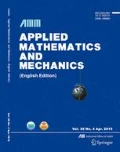Abstract
The evolution of low-speed streaks in the turbulent boundary layer of the minimum channel flow unit at a low Reynolds number is simulated by the direct numerical simulation (DNS) based on the standard Fourier-Chebyshev spectral method. The subharmonic sinuous (SS) mode for two spanwise-aligned low-speed streaks is excited by imposing the initial perturbations. The possibilities and the physical realities of the turbulent sustaining in the minimal channel unit are examined. Based on such a flow field environment, the evolution of the low-speed streaks during a cycle of turbulent sustaining, including lift-up, oscillation, and breakdown, is investigated. The development of streamwise vortices and the dynamics of vortex structures are examined. The results show that the vortices generated from the same streak are staggered along the streamwise direction, while the vortices induced by different streaks tilt toward the normal direction due to the mutual induction effect. It is the spatial variations of the streamwise vortices that cause the lift-up of the streaks. By resolving the transport dynamics of enstrophy, the strength of the vortices is found to continuously grow in the logarithmic layer through the vortex stretching mechanism during the evolution of streaks. The enhancement of the vortices contributes to the spanwise oscillation and the following breakdown of the low-speed streaks.
Similar content being viewed by others
References
Ge, M. W., Xu, C. X., and Cui, G. X. Direct numerical simulation of flow in channel with timedependent wall geometry. Applied Mathematics and Mechanics (English Edition), 31(1), 97–108 (2010) DOI 10.1007/s10483-010-0110-x
Chen, L., Tang, D. B., and Liu, C. Q. Numerical studies on evolution of secondary streamwise vortices in transitional boundary layers. Applied Mathematics and Mechanics (English Edition), 32(4), 449–458 (2011) DOI 10.1007/s10483-011-1429-9
Kawahara, G., Jiménez, J., Uhlmann, M., and Pinelli, A. Annual Research Briefs, NASA-Stanford University Center for Turbulence Research, Stanford, 155–170 (1998)
Kline, S. J., Reynolds, W. C., and Schraub, F. A. The structure of turbulent boundary layers. Journal of Fluid Mechanics, 30, 741–773 (1967)
Swearingen, J. D. and Blackwelder, R. F. The growth and breakdown of streamwise vortices in the presence of a wall. Journal of Fluid Mechanics, 182, 255–290 (1987)
Yu, X. and Liu, J. T. C. The secondary instability in Görtler flow. Physics of Fluids, A3, 1845–1847 (1967)
Hamilton, J. M., Kim, J., and Waleffe, F. Regeneration mechanisms of near-wall turbulence structures. Journal of Fluid Mechanics, 287, 317–348 (1995)
Jiménez, J. and Pinelli, A. The autonomous cycle of near-wall turbulence. Journal of Fluid Mechanics, 389, 335–359 (1999)
Li, F. and Malik, M. R. Fundamental and subharmonic secondary instabilities of Görtler vortices. Journal of Fluid Mechanics, 297, 77–100 (1995)
Andersson, P., Brandt, L., and Bottaro, A. On the breakdown of boundary layer streaks. Journal of Fluid Mechanics, 428, 29–60 (2001)
Schoppa, W. and Hussain, F. Coherent structure dynamics in near-wall turbulence. Fluid Dynamics Research, 26, 119–139 (2000)
Schoppa, W. and Hussain, F. Coherent structure generation in near-wall turbulence. Journal of Fluid Mechanics, 453, 57–108 (2002)
Konishi, Y. and Asai, M. Experimental investigation of the instability of spanwise-periodic lowspeed streak. Fluid Dynamics Research, 34, 299–315 (2004)
Liu, Y., Zaki, T. A., and Durbin, P. A. Floquet analysis of secondary instability of boundary layers distorted by Klebanoff streaks and Tollmien-Schlichting waves. Physics of Fluids, 20(12), 124102 (2008)
Jiménez, J. and Moin, P. The minimal flow unit in near-wall turbulence. Journal of Fluid Mechanics, 225, 213–240 (1991)
Canuto, C., Hussaini, M. Y., Quarteroni, A., and Zang, T. A. Spectral Methods in Fluid Dynamics, Springer-Verlag, New York (1988)
Huang, L. P., Fan, B. C., and Dong, G. Turbulent drag reduction via a transverse wave travelling along stream direction induced by Lorentz force. Physics of Fluids, 22, 015103 (2010)
Jeong, J., Hussain, F., Schoppa, W., and Kim, J. Coherent structures near the wall in a turbulent channel flow. Journal of Fluid Mechanics, 332, 185–214 (1997)
Wei, T. and Willmarth, W. W. Reynolds number effects on the structure of a turbulent channel flow. Journal of Fluid Mechanics, 204, 57–95 (1989)
Iwamoto, K. Database of Fully Developed Channel Flow, THTLAB Internal Report, ILR-0201, The University of Tokyo, Tokyo (2003)
Buxton, O. R. H. and Ganapathisubramani, B. Amplication of enstrophy in the far field of an axisymmetric turbulent jet. Journal of Fluid Mechanics, 651, 483–502 (2010)
Wang, B. C., Yee, E., and Bergstrom, D. J. Geometrical properties of the vorticity vector derived using large-eddy simulation. Fluid Dynamics Research, 40, 123–154 (2008)
Author information
Authors and Affiliations
Corresponding author
Additional information
Project supported by the National Natural Science Foundation of China (No. 11202102), the Innovation Project for College Graduates of Jiangsu Province (No.CXZZ13 0189), and the Specialized Research Fund for Doctoral Program of Higher Education of China (No. 20123219120050)
Rights and permissions
About this article
Cite this article
Li, J., Dong, G. Numerical simulation on evolution of subharmonic low-speed streaks in minimal channel turbulent flow. Appl. Math. Mech.-Engl. Ed. 34, 1069–1082 (2013). https://doi.org/10.1007/s10483-013-1728-9
Received:
Revised:
Published:
Issue Date:
DOI: https://doi.org/10.1007/s10483-013-1728-9



